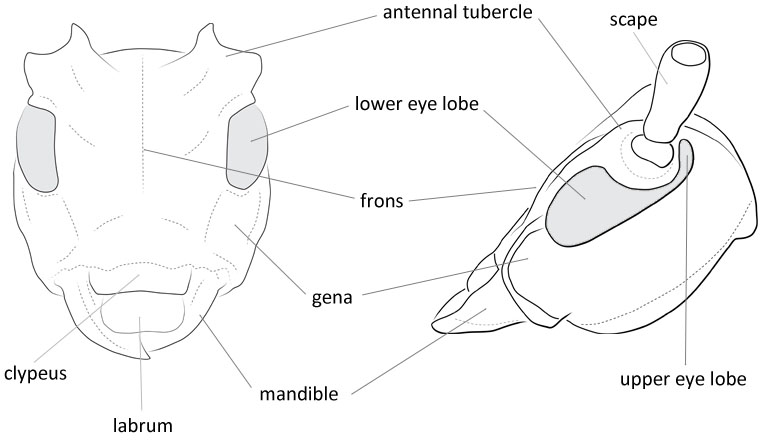Body length: 10–24 mm.
Eyes: eye interommatidial setaeseta:
a sclerotized hair-like projection of the cuticle
absent, eye entire/shallowly emarginateemarginate:
notched at the margin , eye ommatidial density coarse.
, eye ommatidial density coarse.
Antennaeantenna:
in larval and adult insects, paired segmented appendages, borne one on each side of the head, functioning as sense organs and bearing a large number of sensilla
: antennal length barely surpassing pronotumpronotum:
the upper and dorsal part of the prothorax
or shorter, antennal flagellar segments elongateelongate:
much longer than wide
or quadrate, scapescape:
the first proximal segment of the antenna smooth/punctate at apexapex:
smooth/punctate at apexapex:
end of any structure distad to the base
, antennal scapescape:
the first proximal segment of the antenna ≥ segment 3.
≥ segment 3.
Pronotumpronotum:
the upper and dorsal part of the prothorax
: pronotumpronotum:
the upper and dorsal part of the prothorax
shape transversetransverse:
broader than long
, pronotumpronotum:
the upper and dorsal part of the prothorax
lateral armature absent.
Prosternum: prosternal processprosternal process:
a posterior extension of the prosternum between the coxae dilated at apexapex:
dilated at apexapex:
end of any structure distad to the base
, procoxal cavities open posteriorly.
Elytraelytron:
the leathery forewing of beetles, serving as a covering for the hind wings, commonly meeting opposite elytron in a straight line down the middle of the dorsum in repose
: elytral length reaching or close to end of abdomen, elytral apicesapex:
end of any structure distad to the base
rounded or truncatetruncate:
cut off squarely at the tip
, elytral color black, elytral color pattern absent.
Legs: visible tarsomerestarsomere:
subdivision or article of the tarsus, usually numbering from two to five : 5, femora robust, protibial spursprotibial spur:
: 5, femora robust, protibial spursprotibial spur:
sclerotized spine(s) located at the distal tibia; can be single, double, or absent : 2, tarsal clawstarsal claw:
: 2, tarsal clawstarsal claw:
usually paired claws of the pretarsus, at the distal end of the leg simple.
simple.
Body thick, cylindricalcylindrical:
shaped like a cylinder, parallel sided
. Antennaeantenna:
in larval and adult insects, paired segmented appendages, borne one on each side of the head, functioning as sense organs and bearing a large number of sensilla
short, reach slightly beyond middle of pronotumpronotum:
the upper and dorsal part of the prothorax
or even do not reach it. Foretibiae broaden toward apexapex:
end of any structure distad to the base
, crenate on outer margin, extending into long spinespine:
a protuberance with an acute (sharp) distal end
apically (Cherepanov 1988aCherepanov 1988a:
Cherepanov AI. 1988a. Cerambycidae of Northern Asia, Volume 1. Prioninae, Disteniinae, Lepturinae, Aseminae. Oxonian Press, New Delhi 1: i–xvi + 1–642, 296 figs.).
The non-transverse antennal segments, second antennal segment ½ the length of third, and black integument will distinguish from Scaphinus. The globose pronotumpronotum:
the upper and dorsal part of the prothorax
, open procoxal cavities, teeth on outer side of tibiaetibia:
the leg segment distal to the femur, proximal to the tarsus
, and toothed cutting edge of mandibles distinguish from Neospondylis.
Largely distributed in coniferous forests of most of Palaearctic Region, from Europe to Japan.
Pinus
monotypic
Sphondyla Illiger, 1804
Spondylus C. G. Thomson, 1866
Spondylis Fabricius, 1775